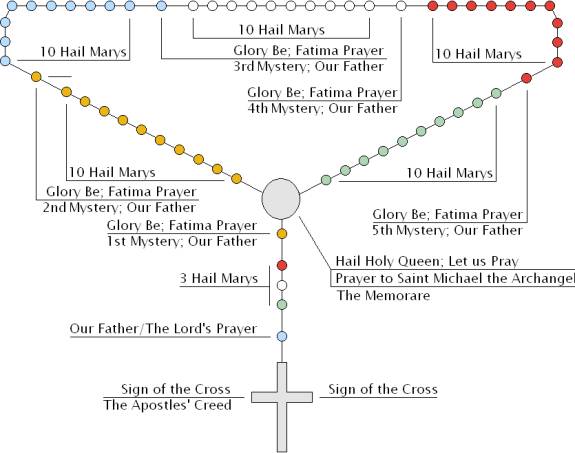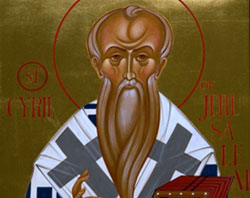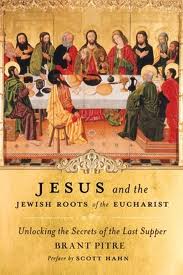CW4 Our Lady of the Rosary – Praying with the Blessed Virgin Mary – The 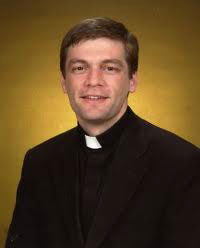 Great Cloud of Witnesses: Guides for Prayer with Fr. Mark Cyza
Great Cloud of Witnesses: Guides for Prayer with Fr. Mark Cyza
[powerpress]
Fr. Mark Cyza discusses praying with Our Lady of the Holy Rosary. Â He speaks of the history of the devotion., as well as, Â the importance of spending time in contemplation of the saving mysteries of our salvation. Â Fr. Cyza explains why should welcome the opportunity to pray with Blessed Virgin Mary and how she walks with us in her great garden of prayer.
Resources:
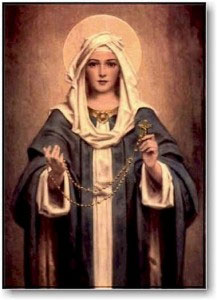 Visit the
Visit the
Discerning Hearts
Holy Rosary Page
here
Tags: blessed virgin mary, contemplation, Mark Cyza, mysteries, prayer
This entry was posted on Saturday, October 12th, 2013 at 3:05 pm
You can follow any responses to this entry through the RSS 2.0 feed.
Dr. Matthew Bunson discusses the life, times and teachings of  St. Cyril of Jerusalem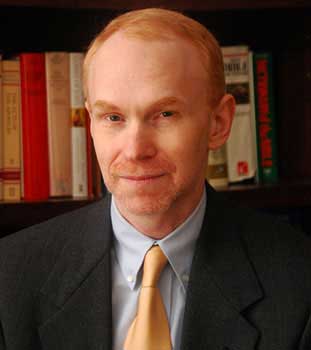
[powerpress]
For more on St. Cyril and his teachings
Taken as a whole, Cyril’s homilies form a systematic catechesis on the Christian’s rebirth through Baptism.
He tells the catechumen: “You have been caught in the nets of the Church (cf. Mt 13: 47). Be taken alive, therefore; do not escape for it is Jesus who is fishing for you, not in order to kill you but to resurrect you after death. Indeed, you must die and rise again (cf. Rom 6: 11, 14)…. Die to your sins and live to righteousness from this very day” (Procatechesis, 5).
From the doctrinal viewpoint, Cyril commented on the Jerusalem Creed with recourse to the typology of
the Scriptures in a “symphonic” relationship between the two Testaments, arriving at Christ, the centre of the universe.
The typology was to be described decisively by Augustine of Hippo: “In the Old Testament there is a veiling of the New, and in the New Testament there is a revealing of the Old” (De catechizandis rudibus 4, 8).
As for the moral catechesis, it is anchored in deep unity to the doctrinal catechesis: the dogma progressively descends in souls who are thus urged to transform their pagan behaviour on the basis of new life in Christ, a gift of Baptism.
The “mystagogical” catechesis, lastly, marked the summit of the instruction that Cyril imparted, no longer to catechumens but to the newly baptized or neophytes during Easter week. He led them to discover the mysteries still hidden in the baptismal rites of the Easter Vigil.
Enlightened by the light of a deeper faith by virtue of Baptism, the neophytes were at last able to understand these mysteries better, having celebrated their rites.
For more visit Vatican.va
Dr. Matthew Bunson, Senior Fellow of the St. Paul Center for Biblical Theology, is one of the United States’ leading authorities on the papacy and the Church.
His books include: The Encyclopedia of Catholic History; The Encyclopedia of Saints; Papal Wisdom; All Shall Be Well; Encyclopedia of the Roman Empire; and The Angelic Doctor: The Life and World of St. Thomas Aquinas; The Pope Encyclopedia; We Have a Pope! Benedict XVI, the first Catholic biography of the Holy Father in the English language; the Encyclopedia of U.S. Catholic History; Pope Francis. Â His also the editor of OSV’s “The Catholic Answer” magazine.
Tags: AD, Church, Israel, matthew bunson, mysteries
This entry was posted on Saturday, September 28th, 2013 at 7:54 am
You can follow any responses to this entry through the RSS 2.0 feed.
Stunning…simply stunning. I love “Mysteries of the Virgin Mary: Living Our Lady’s Graces”! A beautiful and lovingly assembled collection of and meditations on the 13 principal Marian mysteries celebrated by the Church. From the sound theological foundations for our devotion to Our Lady to the reflections and teachings of the saints, Fr. Peter John Cameron, founding editor-in-chief of the monthly worship aid Magnificat, has given us a wonderful resource to deepen our walk with the Blessed Mother of God.
Graces”! A beautiful and lovingly assembled collection of and meditations on the 13 principal Marian mysteries celebrated by the Church. From the sound theological foundations for our devotion to Our Lady to the reflections and teachings of the saints, Fr. Peter John Cameron, founding editor-in-chief of the monthly worship aid Magnificat, has given us a wonderful resource to deepen our walk with the Blessed Mother of God.
[powerpress]
 You kind find this book at www.servantbooks.org
You kind find this book at www.servantbooks.org
Here is the extended web-exclusive edition of our “Inside the Pages” interview with Fr. Cameron[powerpress url=”http://www.old.discerninghearts.com/interviews/Inside_the_Pages-Fr_Peter_John_Cameron_special_extended_edition.mp3″]Download (right click & choose “Save Link As”)
Tags: blessed mother, Church, devotion, graces, marian, meditations, mother of god, mysteries, peter john cameron, reflections, saints, servant books, virgin mary
This entry was posted on Thursday, September 12th, 2013 at 11:13 am
You can follow any responses to this entry through the RSS 2.0 feed.
Mike Aquilina offers us deep insight on the life of St. Cyril of Jerusalem.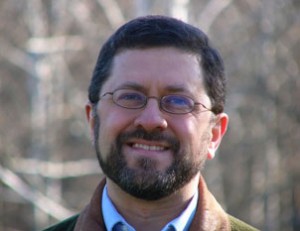
[powerpress]
More on St. Cyril of Jerusalem from vatican.va:
BENEDICT XVI’s GENERAL AUDIENCE
Paul VI Audience Hall
Wednesday, 27 June 2007
Dear Brothers and Sisters,
Our attention today is focused on St Cyril of Jerusalem. His life is woven of two dimensions: on the one hand, pastoral care, and on the other, his involvement, in spite of himself, in the heated controversies that were then tormenting the Church of the East.
Cyril was born at or near Jerusalem in 315 A.D. He received an excellent literary education which formed the basis of his ecclesiastical culture, centred on study of the Bible. He was ordained a priest by Bishop Maximus.
When this Bishop died or was deposed in 348, Cyril was ordained a Bishop by Acacius, the influential Metropolitan of Caesarea in Palestine, a philo-Arian who must have been under the impression that in Cyril he had an ally; so as a result Cyril was suspected of having obtained his episcopal appointment by making concessions to Arianism.
Actually, Cyril very soon came into conflict with Acacius, not only in the field of doctrine but also in that of jurisdiction, because he claimed his own See to be autonomous from the Metropolitan See of Caesarea.
Cyril was exiled three times within the course of approximately 20 years: the first time was in 357, after being deposed by a Synod of Jerusalem; followed by a second exile in 360, instigated by Acacius; and finally, in 367, by a third exile – his longest, which lasted 11 years – by the philo-Arian Emperor Valens.
It was only in 378, after the Emperor’s death, that Cyril could definitively resume possession of his See and restore unity and peace to his faithful.
Some sources of that time cast doubt on his orthodoxy, whereas other equally ancient sources come out strongly in his favour. The most authoritative of them is the Synodal Letter of 382 that followed the Second Ecumenical Council of Constantinople (381), in which Cyril had played an important part.
In this Letter addressed to the Roman Pontiff, the Eastern Bishops officially recognized Cyril’s flawless orthodoxy, the legitimacy of his episcopal ordination and the merits of his pastoral service, which ended with his death in 387.
Of Cyril’s writings, 24 famous catecheses have been preserved, which he delivered as Bishop in about 350.
Introduced by a Procatechesis of welcome, the first 18 of these are addressed to catechumens or candidates for illumination (photizomenoi) [candidates for Baptism]; they were delivered in the Basilica of the Holy Sepulchre. Each of the first ones (nn. 1-5) respectively treat the prerequisites for Baptism, conversion from pagan morals, the Sacrament of Baptism, the 10 dogmatic truths contained in the Creed or Symbol of the faith.
The next catecheses (nn. 6-18) form an “ongoing catechesis” on the Jerusalem Creed in anti-Arian tones.
Of the last five so-called “mystagogical catecheses”, the first two develop a commentary on the rites of Baptism and the last three focus on the Chrism, the Body and Blood of Christ and the Eucharistic Liturgy. They include an explanation of the Our Father (Oratio dominica).
This forms the basis of a process of initiation to prayer which develops on a par with the initiation to the three Sacraments of Baptism, Confirmation and the Eucharist.
The basis of his instruction on the Christian faith also served to play a polemic role against pagans, Judaeo Christians and Manicheans. The argument was based on the fulfilment of the Old Testament promises, in a language rich in imagery.
Catechesis marked an important moment in the broader context of the whole life – particularly liturgical – of the Christian community, in whose maternal womb the gestation of the future faithful took place, accompanied by prayer and the witness of the brethren.
Taken as a whole, Cyril’s homilies form a systematic catechesis on the Christian’s rebirth through Baptism.
He tells the catechumen: “You have been caught in the nets of the Church (cf. Mt 13: 47). Be taken alive, therefore; do not escape for it is Jesus who is fishing for you, not in order to kill you but to resurrect you after death. Indeed, you must die and rise again (cf. Rom 6: 11, 14)…. Die to your sins and live to righteousness from this very day” (Procatechesis, 5).
From the doctrinal viewpoint, Cyril commented on the Jerusalem Creed with recourse to the typology of the Scriptures in a “symphonic” relationship between the two Testaments, arriving at Christ, the centre of the universe.
The typology was to be described decisively by Augustine of Hippo: “In the Old Testament there is a veiling of the New, and in the New Testament there is a revealing of the Old” (De catechizandis rudibus 4, 8).
As for the moral catechesis, it is anchored in deep unity to the doctrinal catechesis: the dogma progressively descends in souls who are thus urged to transform their pagan behaviour on the basis of new life in Christ, a gift of Baptism.
The “mystagogical” catechesis, lastly, marked the summit of the instruction that Cyril imparted, no longer to catechumens but to the newly baptized or neophytes during Easter week. He led them to discover the mysteries still hidden in the baptismal rites of the Easter Vigil.
Enlightened by the light of a deeper faith by virtue of Baptism, the neophytes were at last able to understand these mysteries better, having celebrated their rites.
Especially with neophytes of Greek origin, Cyril made use of the faculty of sight which they found congenial. It was the passage from the rite to the mystery that made the most of the psychological effect of amazement, as well as the experience of Easter night.
Here is a text that explains the mystery of Baptism: “You descended three times into the water, and ascended again, suggesting by a symbol the three days burial of Christ, imitating Our Saviour who spent three days and three nights in the heart of the earth (cf. Mt 12: 40). Celebrating the first emersion in water you recall the first day passed by Christ in the sepulchre; with the first immersion you confessed the first night passed in the sepulchre: for as he who is in the night no longer sees, but he who is in the day remains in the light, so in the descent, as in the night, you saw nothing, but in ascending again you were as in the day. And at the self-same moment you were both dying and being born; and that water of salvation was at once your grave and your mother…. For you… the time to die goes hand in hand with the time to be born: one and the same time effected both of these events” (cf. Second Mystagogical Catechesis, n. 4).
The mystery to be understood is God’s plan, which is brought about through Christ’s saving actions in the Church.
In turn, the mystagogical dimension is accompanied by the dimension of symbols which express the spiritual experience they “explode”. Thus, Cyril’s catechesis, on the basis of the three elements described – doctrinal, moral and lastly, mystagogical – proves to be a global catechesis in the Spirit.
The mystagogical dimension brings about the synthesis of the two former dimensions, orienting them to the sacramental celebration in which the salvation of the whole human person takes place.
In short, this is an integral catechesis which, involving body, soul and spirit – remains emblematic for the catechetical formation of Christians today.
Tags: Church, doctor of the church, faith, father of the church, mike aquilina, mysteries, st cyril of jerusalem
This entry was posted on Monday, March 18th, 2013 at 12:04 am
You can follow any responses to this entry through the RSS 2.0 feed.
Part 2…What a fantastic book, what a fantastic (and fun) interview with Dr. Brant Pitre, discussing “Jesus and the Jewish 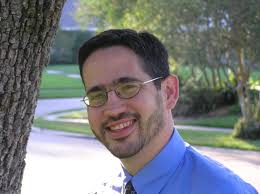 Roots of the Eucharist”. This book has what it takes to become a classic, similiar in importance as Dr. Scott Hahn’s “The Lamb’s Supper”!
Roots of the Eucharist”. This book has what it takes to become a classic, similiar in importance as Dr. Scott Hahn’s “The Lamb’s Supper”!
The description from the book says it best….“Jesus and the Jewish Roots of the Eucharist shines fresh light on the Last Supper by looking at it through Jewish eyes. Using his in-depth knowledge of the Bible and ancient Judaism, Dr. Brant Pitre answers questions such as: What was the Passover like at the time of Jesus? What were the Jewish hopes for the Messiah? What was Jesus’ purpose in instituting the Eucharist during the feast of Passover? And, most important of all, what did Jesus mean when he said, “This is my body… This is my bloodâ€?
To answer these questions, Pitre explores ancient Jewish beliefs about the Passover of the Messiah, the miraculous Manna from heaven, and the mysterious Bread of the Presence. As he shows, these three keys—the Passover, the Manna, and the Bread of the Presence—have the power to unlock the original meaning of the Eucharistic words of Jesus. Along the way, Pitre also explains how Jesus united the Last Supper to his death on Good Friday and his Resurrection on Easter Sunday.
Inspiring and informative, Jesus and the Jewish Roots of the Eucharist is a groundbreaking work that is sure to illuminate one of the greatest mysteries of the Christian faith: the mystery of Jesus’ presence in “the breaking of the bread.â€
[powerpress]
and be sure to check out Dr. Brant Pitre’s excellent website!
Tags: ancient judaism, brant pitre, catholic, catholic podcast, catholic prayer, cathollc spirituality, doubleday religion, eucharist, Jesus, mysteries, work
This entry was posted on Monday, February 14th, 2011 at 7:58 am
You can follow any responses to this entry through the RSS 2.0 feed.
What a fantastic book, what a fantastic (and fun) interview with Dr. Brant Pitre, discussing “Jesus and the Jewish  Roots of the Eucharist”. This book has what it takes to become a classic, similiar in importance as Dr. Scott Hahn’s “The Lamb’s Supper”!
Roots of the Eucharist”. This book has what it takes to become a classic, similiar in importance as Dr. Scott Hahn’s “The Lamb’s Supper”!
The description from the book says it best….“Jesus and the Jewish Roots of the Eucharist shines fresh light on the Last Supper by looking at it through Jewish eyes. Using his in-depth knowledge of the Bible and ancient Judaism, Dr. Brant Pitre answers questions such as: What was the Passover like at the time of Jesus? What were the Jewish hopes for the Messiah? What was Jesus’ purpose in instituting the Eucharist during the feast of Passover? And, most important of all, what did Jesus mean when he said, “This is my body… This is my bloodâ€?
To answer these questions, Pitre explores ancient Jewish beliefs about the Passover of the Messiah, the miraculous Manna from heaven, and the mysterious Bread of the Presence. As he shows, these three keys—the Passover, the Manna, and the Bread of the Presence—have the power to unlock the original meaning of the Eucharistic words of Jesus. Along the way, Pitre also explains how Jesus united the Last Supper to his death on Good Friday and his Resurrection on Easter Sunday.
Inspiring and informative, Jesus and the Jewish Roots of the Eucharist is a groundbreaking work that is sure to illuminate one of the greatest mysteries of the Christian faith: the mystery of Jesus’ presence in “the breaking of the bread.â€
and be sure to check out Dr. Brant Pitre’s excellent website!
Tags: brant pitre, catholic, catholic podcast, catholic prayer, cathollc spirituality, doubleday religion, feast of passover, Jesus, jewish roots, last supper, manna from heaven, mysteries, work
This entry was posted on Friday, February 11th, 2011 at 12:38 am
You can follow any responses to this entry through the RSS 2.0 feed.
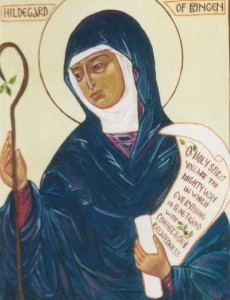 Once again the Holy Father, Pope Benedict XVI speaks of the importance of St. Hildegard of Bingen.
Once again the Holy Father, Pope Benedict XVI speaks of the importance of St. Hildegard of Bingen.
Vatican City – Pope Benedict’s General Audience from Vatican.va
Dear Brothers and Sisters, Today I would like to take up and continue my Reflection on St Hildegard of Bingen, an important female figure of the Middle Ages who was distinguished for her spiritual wisdom and the holiness of her life. Hildegard’s mystical visions resemble those of the Old Testament prophets: expressing herself in the cultural and religious categories of her time, she interpreted the Sacred Scriptures in the light of God, applying them to the various circumstances of life. Thus all those who heard her felt the need to live a consistent and committed Christian lifestyle. In a letter to St Bernard the mystic from the Rhineland confesses: “The vision fascinates my whole being: I do not see with the eyes of the body but it appears to me in the spirit of the mysteries…. I recognize the deep meaning of what is expounded on in the Psalter, in the Gospels and in other books, which have been shown to me in the vision. This vision burns like a flame in my breast and in my soul and teaches me to understand the text profoundly” (Epistolarium pars prima I-XC: CCCM 91). Hildegard’s mystical visions have a rich theological content. They refer to the principal events of salvation history, and use a language for the most part poetic and symbolic. For example, in her best known work entitled Scivias, that is, “You know the ways” she sums up in 35 visions the events of the history of salvation from the creation of the world to the end of time. With the characteristic traits of feminine sensitivity, Hildegard develops at the very heart of her work the theme of the mysterious marriage between God and humanity that is brought about in the Incarnation. On the tree of the Cross take place the nuptials of the Son of God with the Church, his Bride, filled with grace and the ability to give new children to God, in the love of the Holy Spirit (cf. Visio tertia: PL 197, 453c).
From these brief references we already see that theology too can receive a special contribution from women because they are able to talk about God and the mysteries of faith using their own particular intelligence and sensitivity. I therefore encourage all those who carry out this service to do it with a profound ecclesial spirit, nourishing their own reflection with prayer and looking to the great riches, not yet fully explored, of the medieval mystic tradition, especially that represented by luminous models such as Hildegard of Bingen.
The Rhenish mystic is also the author of other writings, two of which are particularly important since, like Scivias, they record her mystical visions: they are the Liber vitae meritorum (Book of the merits of life) and the Liber divinorum operum (Book of the divine works), also called De operatione Dei. In the former she describes a unique and powerful vision of God who gives life to the cosmos with his power and his light. Hildegard stresses the deep relationship that exists between man and God and reminds us that the whole creation, of which man is the summit, receives life from the Trinity. The work is centred on the relationship between virtue and vice, which is why human beings must face the daily challenge of vice that distances them on their way towards God and of virtue that benefits them. The invitation is to distance themselves from evil in order to glorify God and, after a virtuous existence, enter the life that consists “wholly of joy”. In her second work that many consider her masterpiece she once again describes creation in its relationship with God and the centrality of the human being, expressing a strong Christo-centrism with a biblical-Patristic flavour. The Saint, who presents five visions inspired by the Prologue of the Gospel according to St John, cites the words of the Son to the Father: “The whole task that you wanted and entrusted to me I have carried out successfully, and so here I am in you and you in me and we are one” (Pars III, Visio X: PL 197, 1025a). Finally, in other writings Hildegard manifests the versatility of interests and cultural vivacity of the female monasteries of the Middle Ages, in a manner contrary to the prejudices which still weighed on that period. Hildegard took an interest in medicine and in the natural sciences as well as in music, since she was endowed with artistic talent. Thus she composed hymns, antiphons and songs, gathered under the title: Symphonia Harmoniae Caelestium Revelationum (Symphony of the Harmony of Heavenly Revelations), that were performed joyously in her monasteries, spreading an atmosphere of tranquillity and that have also come down to us. For her, the entire creation is a symphony of the Holy Spirit who is in himself joy and jubilation.
The popularity that surrounded Hildegard impelled many people to seek her advice. It is for this reason that we have so many of her letters at our disposal. Many male and female monastic communities turned to her, as well as Bishops and Abbots. And many of her answers still apply for us. For instance, Hildegard wrote these words to a community of women religious: “The spiritual life must be tended with great dedication. At first the effort is burdensome because it demands the renunciation of caprices of the pleasures of the flesh and of other such things. But if she lets herself be enthralled by holiness a holy soul will find even contempt for the world sweet and lovable. All that is needed is to take care that the soul does not shrivel” (E. Gronau, Hildegard. Vita di una donna profetica alle origini dell’età moderna, Milan 1996, p. 402). And when the Emperor Frederic Barbarossa caused a schism in the Church by supporting at least three anti-popes against Alexander iii, the legitimate Pope, Hildegard did not hesitate, inspired by her visions, to remind him that even he, the Emperor, was subject to God’s judgement. With fearlessness, a feature of every prophet, she wrote to the Emperor these words as spoken by God: “You will be sorry for this wicked conduct of the godless who despise me! Listen, O King, if you wish to live! Otherwise my sword will pierce you!” (ibid., p. 412). With the spiritual authority with which she was endowed, in the last years of her life Hildegard set out on journeys, despite her advanced age and the uncomfortable conditions of travel, in order to speak to the people of God. They all listened willingly, even when she spoke severely: they considered her a messenger sent by God. She called above all the monastic communities and the clergy to a life in conformity with their vocation. In a special way Hildegard countered the movement of German cátari (Cathars). They cátari means literally “pure” advocated a radical reform of the Church, especially to combat the abuses of the clergy.
She harshly reprimanded them for seeking to subvert the very nature of the Church, reminding them that a true renewal of the ecclesial community is obtained with a sincere spirit of repentance and a demanding process of conversion, rather than with a change of structures. This is a message that we should never forget. Let us always invoke the Holy Spirit, so that he may inspire in the Church holy and courageous women, like St Hildegard of Bingen, who, developing the gifts they have received from God, make their own special and valuable contribution to the spiritual development of our communities and of the Church in our time.
Tags: catholic, catholic podcast, catholic prayer, cathollc spirituality, Church, courageous women, Hildegard of Bingen, holy spirit, mysteries, mystic of the Church, mystics, pope benedict, pope benedict xvi, st hildegard of bingen, women, women of the middle ages
This entry was posted on Wednesday, September 8th, 2010 at 4:08 pm
You can follow any responses to this entry through the RSS 2.0 feed.

